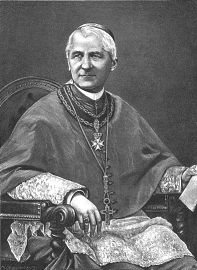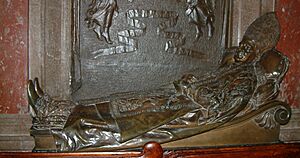Mieczysław Halka-Ledóchowski facts for kids
Quick facts for kids Mieczysław Halka-Ledóchowski |
|
|---|---|
| Prefect of the Congregation for the Propagation of the Faith | |
 |
|
| Church | Roman Catholic Church |
| Appointed | 26 January 1892 |
| Reign ended | 22 July 1902 |
| Predecessor | Giovanni Simeoni |
| Successor | Girolamo Maria Gotti |
| Other posts |
|
| Orders | |
| Ordination | 13 July 1845 |
| Consecration | 3 November 1861 by Camillo di Pietro |
| Created Cardinal | 15 March 1875 |
| Rank | Cardinal-Priest |
| Personal details | |
| Birth name | Mieczysław Halka-Ledóchowski |
| Born | 29 October 1822 Górki, Congress Poland |
| Died | 22 July 1902 (aged 79) Rome, Kingdom of Italy |
| Buried | Campo Verano (1902–27) Poznań Cathedral |
| Parents | Josef Ledóchowski Maria Rosalia Zakrzewska |
| Previous post |
|
| Alma mater | Pontifical Academy of Ecclesiastical Nobles Collegio Romano |
| Coat of arms |  |
| Styles of Mieczysław Ledóchowski |
|
|---|---|
 |
|
| Reference style | His Eminence |
| Spoken style | Your Eminence |
| Informal style | Cardinal |
| See | Poznań and Gniezno |
Mieczysław Halka-Ledóchowski (born October 29, 1822 – died July 22, 1902) was an important leader in the Roman Catholic Church. He was born in Górki, a town near Sandomierz in Congress Poland, which was then part of the Russian Empire. He became a Cardinal, which is a very high rank in the Church.
He is also known for standing up for his people and their language during a difficult time in Poland. Mieczysław was the uncle of Saint Ursula Ledóchowska and Blessed Maria Teresia Ledóchowska, who were also important figures in the Church.
His Early Life and Studies
Mieczysław Ledóchowski was born on October 29, 1822. He was named after Mieszko I, who was the first Christian prince of Poland.
He began his studies in Radom, Poland. When he was 19, he joined a seminary in Warsaw. A seminary is a special school where people study to become priests. He then went to the Gregorian University in Rome. After that, he attended the Pontifical Ecclesiastical Academy, which trains people to work as diplomats for the Pope.
Mieczysław Ledóchowski became a priest on July 13, 1845. He was a very good student and earned two doctorates. These were advanced degrees in theology (the study of religious faith) and in civil and canon law (laws of the country and the Church).
Working for the Pope Around the World
After becoming a priest, Father Ledóchowski started his career working for Pope Pius IX. In 1846, he became a "domestic prelate," which is an honorary title given by the Pope. The next year, he worked at the Pope's office in Lisbon, Portugal.
In 1857, he became a special representative for the Pope in Bogota. This area included several countries in South America, such as present-day Colombia, Venezuela, Ecuador, Peru, and Bolivia. His job was to represent the Pope and the Church in these regions.
Later, in 1861, he was named an Archbishop and became the Pope's official representative, called a "nuncio," in Brussels, Belgium.
Standing Up for His People in Poland
In 1864, Mieczysław Ledóchowski returned to Poland. He was appointed as the Archbishop of Gniezno and Archbishop of Poznań in 1866. These were important leadership roles for the Church in Poland. At that time, these cities were part of the Kingdom of Prussia.
In 1873, the Prussian government started a program called "Kulturkampf." This was a series of laws and policies that aimed to reduce the influence of the Roman Catholic Church and Polish culture. One of these policies was to forbid the use of the Polish language in schools in the region.
Archbishop Ledóchowski strongly disagreed with this order. He sent out a message telling religious teachers to continue using Polish when teaching younger students. He wanted to protect the Polish language and culture.
Because the teachers followed his orders, the Prussian government removed them from their jobs. Ledóchowski also refused to let the government control the seminaries in Gniezno and Poznan. This led to the seminaries being closed.
The government fined him many times for not following their rules. Eventually, they demanded that he resign from his position. Archbishop Ledóchowski bravely replied that no court could take away an office given to him by God. Because of his refusal, he was put in prison in February 1874.
In March 1875, while he was still in prison, the Pope honored him by making him a Cardinal. After being released from prison, he was sent away from Poland. He then led his Church region from Rome, using secret messengers to communicate.
Towards the end of his life, Cardinal Ledóchowski had serious problems with his eyesight. He resigned from his role as Archbishop in 1885. In 1892, he became the Prefect of the Congregation for the Evangelization of Peoples. This is a very important role in the Vatican, where he helped spread the Catholic faith around the world. He held this position until he passed away on July 22, 1902.


